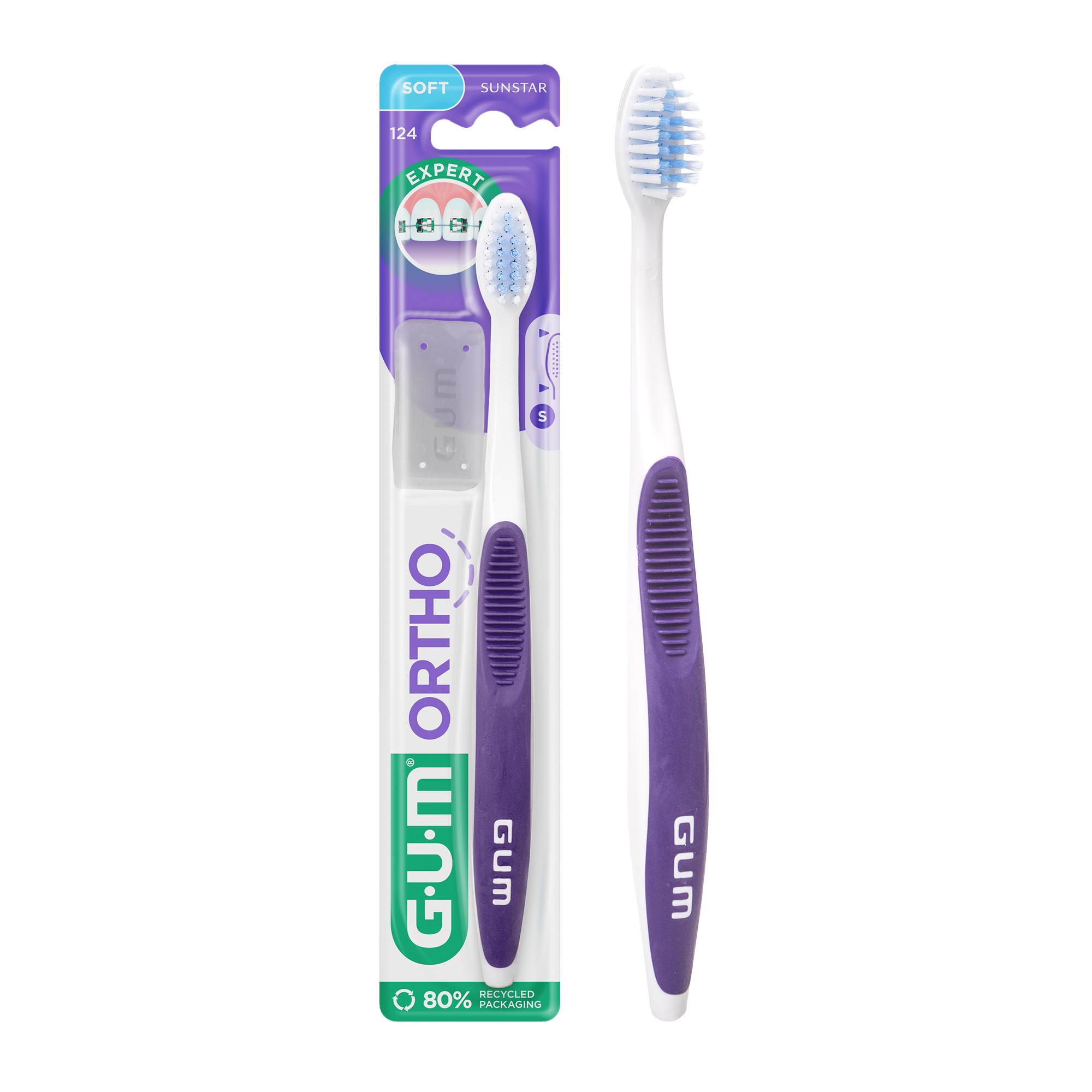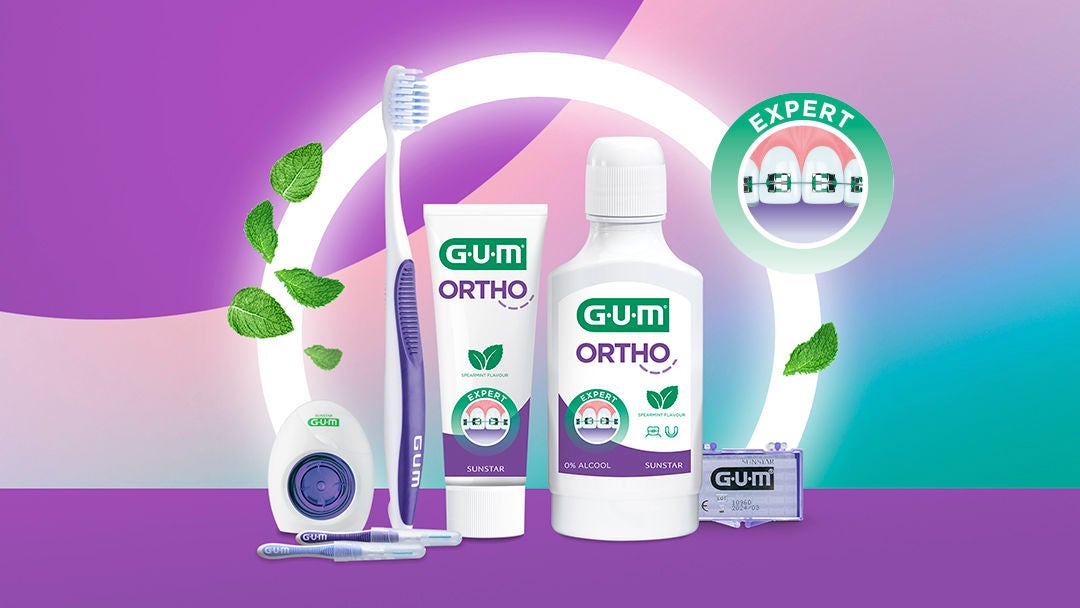
Orthodontics and Braces Care: A Maintenance Guide
For teenagers and adults alike, the prospect of braces can be frustrating, yet ultimately rewarding.

Spending time in the orthodontist’s chair is only the first step towards a lasting, lifelong realignment of teeth, and you’ll come out of the experience with an improved smile and better oral health. But for the process to be worthwhile, you need to put in the effort to maintain your oral health at home. Here’s what good daily care looks like and how to take care of braces the right way.
The basics of braces care: practice a good oral care routine
Brushing, interdental cleaning and rinsing form the foundation of basic oral care. Unfortunately, general brushing - and especially cleaning between teeth - can be difficult with orthodontic appliances like braces, positioners, retainers, and elastics.
This added difficulty frequently dissuades braces-wearers from practising their oral hygiene ritual as closely as they may have before. Not only does this put their oral health at risk, but it can also undermine the reason they invested in orthodontic wear in the first place!
As soon as you get braces, you should adapt your oral health ritual to ensure you’re continuing to clean your teeth and gums effectively. Take the time to review your oral health practices and incorporate the following tips. With diligence and a little practice, you’ll find that keeping your mouth clean isn’t too complicated, no matter what kind of orthodontic appliances you’re wearing.
Brushing
With braces, you need to make it a point to brush at least twice every day for at least two minutes each time. Stick to waiting 30 minutes after a meal before brushing your teeth; however, whenever possible, don’t wait too long to keep food from getting stuck under the brackets and in the spaces between wires and your teeth.
Use a soft-bristled brush like our GUM® ORTHO Toothbrush to reach deep into the spaces between teeth and along the gumline. If you struggle with the toothbrushing technique, you might want to consider using an electric toothbrush with an oscillating brush head. You can also choose a specifically adapted orthodontic toothbrush. Remove any elastics or removable orthodontic equipment from your mouth, then follow these special toothbrushing tips:
- Hold your toothbrush at a 45-degree angle toward the bracket to ensure the bristles reach below the gumline. Use short and gentle strokes and move the toothbrush back and forth to scrub your teeth and remove plaque. Read more about this technique: How to Brush Your Teeth Properly in 4 Easy Steps
- Brush each wire, moving your toothbrush from top to bottom and passing it all the way around the upper and lower teeth.
- Spend 30 seconds on each quadrant of your mouth, moving from top to bottom.
- Brush above, behind and below the brackets and the wire as well, to dislodge stubborn food particles and remove plaque.
- Avoid the urge to overbrush, especially around your gumline. If you’re hurting yourself, you’re brushing too hard.
- When you’re finished brushing, rinse your mouth thoroughly with a fluoride mouthwash.
Using plaque-disclosing tablets while you have braces is a great way to find places you missed during your brushing ritual. These tablets show you where you have a buildup of plaque. Simply chew one and rinse your mouth, and you’ll see stained areas on your teeth, representing the areas of your mouth that have plaque. Brush immediately after using the tablet and until you’ve completely removed the stained area.
Don't forget to brush your tongue!
Interdental cleaning
Interdental cleaning is a much more difficult endeavour with a mouth full of orthodontic appliances, but it is still a crucial element of your oral hygiene ritual. You should continue to clean interdentally (using floss or interdental brushes) daily even while you have braces.
Here are two specially designed tools to make interdental cleaning with braces a breeze:
Interdental brushes enable complete cleaning. For instance, they allow you to clean between two braces, behind the wire: move the interdental brush up and down on both sides of each bracket and move it along the wire when moving from tooth to tooth, moving it up and down while doing so.
Flossing may be slightly more complicated while you have braces, but if you use the right tools, you’ll get the hang of it in no time. For example, a floss threader helps guide the passage of the floss behind the wire.
To use, cut 35-40 cm of floss and run it through the threader. Use the threader to guide the floss between the wiring. Pull the threader through between teeth and appliances. Once the floss is behind the wires, remove the threader and hold the floss as you normally would.
Specific kinds of appliances
Many adults choose to get their braces on the lingual side of their teeth. That is, the braces are on the back of your teeth, near the tongue, and therefore invisible to others. Most of the same techniques mentioned above are appropriate for lingual braces, but it’s important to pay special attention to the back of your teeth, which are more difficult for you to see in the mirror.
Another popular choice for adults these days is a clear aligner.
When you remove the aligners, you can clean your teeth as normal, but don’t forget to clean the aligners themselves! Give them a rinse in water after each use. Brush them gently with clear soap and rinse them in cool or lukewarm water. There’s no need to use harsh chemicals on them.
Children with orthodontics
When your child gets braces or other orthodontic appliances, continue helping them build good oral health care habits. Not only will developing these habits help keep their teeth and gums healthy at this crucial time, but it will also help ensure they continue to care for their teeth and gums after they get their braces off.
Orthodontic professionals frequently recommend children wear a pre-orthodontic removable appliance, such as a retainer. After each meal, a child should remove this retainer and brush it with lukewarm water. Your child should also use a soft-bristled brush to gently scrub away plaque and other debris.
Go the extra mile to protect your mouth
The steps above are the basics, but many orthodontists will recommend going a step further to care for your teeth and gums while you’re wearing braces. Thankfully, there are a lot of proactive orthodontic braces that require very little effort. With that said, here are some ways to be mindful of your appliances.
Use wax to project your soft tissues while adjusting to braces
You may experience discomfort and irritation when wearing orthodontic appliances because of the repeated friction of braces on oral mucosal tissues. Orthodontists recommend using orthodontic wax to form a protective barrier over brackets and wires to improve your comfort level during orthodontic treatment.
Avoid certain foods
Your orthodontist will go over a list of foods you should avoid as soon as you get your braces. During the time you have your braces, be mindful of the foods you eat - especially ones on this list. As a rule, anything sticky, chewy, crunchy, or especially hard is off-limits. Hard candies are particularly problematic when you have braces and can lead to pain or damage to your appliance.
You should take great care to avoid sugary foods and drinks even if you don’t wear orthodontics, but it’s especially important if you do. Sugary foods and drinks can cause major staining and enamel decay around each bracket - especially if brushing habits haven’t caught up to the heightened standards of life with oral appliances. Sometimes, these stains are permanent, and the lesions will need treatment.
Wear a mouthguard
You should always be sure to protect your teeth while participating in sports and other physical activities, but it’s especially important to do so while you have braces. Wear a mouthguard whenever you’re playing sports or participating in other physical activities where full contact impact could occur, even accidentally.
Invest in the right tools right now
The sooner you get all the right tools to properly adapt your oral health care ritual to your orthodontic appliances, the sooner you’ll start rebuilding these important habits.
We can help: our GUM Orthodontic Complete Braces Care Kit provides everything you need to go the extra mile caring for your braces.
Stay motivated by a beautiful and healthy smile
Getting braces seems like a hassle - especially for teens or even adults who may already have anxiety or insecurity. There’s a lot of work required to keep your teeth and braces clean and well-maintained, and you’re also going to spend plenty of time in the orthodontist’s chair getting adjustments and checking on progress. Make sure it’s not for nothing! Good at-home care and mindful practices will make the inconvenience, time and frustration all worth it when your braces come off to reveal a magazine-calibre smile.
While you learn to care for your braces, you’re also gaining another unseen benefit: the peace of mind that comes with a thorough, careful oral care ritual. These good habits will continue long after your braces are off, to help you preserve the smile you’ve worked hard to create.
Want more tips on how to take care of braces?
Looking for products to make braces care easier? The right tools can make a huge difference in the result you see once the braces come off. Have a look at our GUM ORTHO product range or contact us to get more suggestions on braces maintenance and everything else you need for a vibrant healthy smile.





